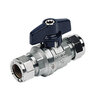- Joined
- 23 Mar 2019
- Messages
- 100
- Reaction score
- 8
- Country

A question regarding replacing an old outside tap.
I’ve purchased a “15mm x 1/2inch outside tap” and a “compression adapting wall plate 90-degree 15mm x 1/2inch” both from S/Fix.
My problem is the tap doesn't line up at the 12o'clock position. When it’s fully tightened it sits a 6o'clock and there appears to be a gap of 1.5mm between the face of the wall plate and the face of the tap connector,...and no amount of ptfe on the threads & boss white will pack it out enough so that I get a good tight compression that lets the tap sits firmly at 12o’clock.
Would I be looking at adding fibre or rubber washers to achieve this vertical position when
it's fully tightened?
If so, what size washers would I need?...I’ve been trying to make sense of what size washers I’d need to fit the tap connector but I’m totally flummoxed to be honest! I can’t make head nor tail of it. Where the hell does 1/2inch enter the equation‽
It must be 30+ years since I last fitted a similar outside tap and I can’t remember having this much kerfuffle. I think a few wraps of ptfe and a smearing of Boss White was all that was needed.
What to do?...as ever all replies gratefully received.
I’ve purchased a “15mm x 1/2inch outside tap” and a “compression adapting wall plate 90-degree 15mm x 1/2inch” both from S/Fix.
My problem is the tap doesn't line up at the 12o'clock position. When it’s fully tightened it sits a 6o'clock and there appears to be a gap of 1.5mm between the face of the wall plate and the face of the tap connector,...and no amount of ptfe on the threads & boss white will pack it out enough so that I get a good tight compression that lets the tap sits firmly at 12o’clock.
Would I be looking at adding fibre or rubber washers to achieve this vertical position when
it's fully tightened?
If so, what size washers would I need?...I’ve been trying to make sense of what size washers I’d need to fit the tap connector but I’m totally flummoxed to be honest! I can’t make head nor tail of it. Where the hell does 1/2inch enter the equation‽
It must be 30+ years since I last fitted a similar outside tap and I can’t remember having this much kerfuffle. I think a few wraps of ptfe and a smearing of Boss White was all that was needed.
What to do?...as ever all replies gratefully received.


